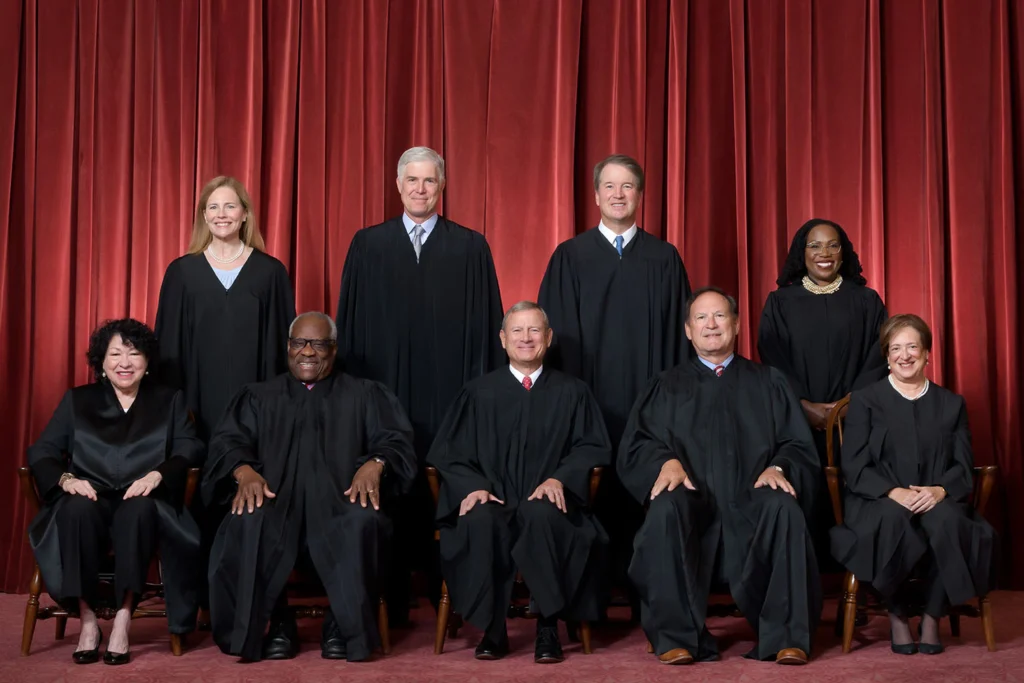
Front row, left to right: Associate Justice Sonia Sotomayor, Associate Justice Clarence Thomas, Chief Justice John G. Roberts, Jr., Associate Justice Samuel A. Alito, Jr., and Associate Justice Elena Kagan. Back row, left to right: Associate Justice Amy Coney Barrett, Associate Justice Neil M. Gorsuch, Associate Justice Brett M. Kavanaugh, and Associate Justice Ketanji Brown Jackson. Credit: Fred Schilling, Collection of the Supreme Court of the United States
… Systemic Racism
The Federalist reports, the Supreme Court determined that race-based admissions violate the 14th Amendment for colleges and universities to prefer some races over others.
A Concept Known as Racism
Chief Justice John Roberts wrote in the majority opinion, “Eliminating racial discrimination means eliminating all of it.”
Smoke from Wildfires, Heat Wave Across the South, Putin: Causing or In Trouble, France Ablaze?
All worthy headlines. But what is capturing America’s immediate attention is the Supreme Court’s decision in Students For Fair Admissions, Inc. v. President and Fellows of Harvard College.” In Spectator, Peter W. Wood writes:
A Winking SCOTUS
Justice Roberts joined by five other members of the Supreme Court ruled that Harvard and the University of North Carolina have been engaged in illegal racial discrimination in the way these institutions selected students for admission. That finding, however, effectively ends the forty-five-year long game in which the Supreme Court has winked at colleges and universities that use racial preferences that were outlawed in 1868 by the Fourteenth Amendment to the US Constitution.
Peter Wood, president of the National Association of Scholars, is a former professor of anthropology and college provost. He is also the author of Wrath: America Enraged and 1620: A Critical Response to the 1619 Project.
By the time the US Supreme Court agreed to hear the Harvard and UNC cases, argues Mr. Wood, “diversity” had long since escaped its original context to justify unjustifiable practices in college admissions. It was being applied to every aspect of education, including the curriculum. In the late 1980s, it jumped into corporate America and then progressed to the “diversity” consulting business.
It was swallowed wholesale by the arts, churches, sports and even greeting card companies. “Diversity” became a watchword for cultural sensitivity in all contexts, though it always had something of a double life. To a mainly white audience, it offered absolution in the form of overcoming racial division. “Diversity is our strength,” et cetera. But to a mainly black audience, it meant gaining access to formerly segregated spaces while being able to maintain a separate identity. This conflict in expectations played out in campus after campus. My colleague Dion Pierre and I wrote a close account of it at the ground zero of racially preferential admissions, in our book, Neo-Segregation at Yale.
Retiring Diversity
As the concept of diversity became increasingly trite, DEI really kicked in.
… the rhetoric of integration and judging people by the “content of their character” was retired completely, replaced by “anti-racism” and inexpungable white guilt.
Mr. Woods acknowledges to not having fully digested the 237 pages of the decisions, the concurring opinions, and the dissents. That, however, didn’t stop the President from giving a ten-minute critique of the decision an hour or so after it was issued. As Mr. Woods civilly accepts, Joe Biden is plainly a faster reader than Wood is. The President obviously is also someone who can cut to the heart of the matter.
(President Joe Biden) observed, “I think that some on the court are beginning to realize that their legitimacy is being questioned in ways that it hasn’t been questioned in the past.”
Mr. Woods is reluctant to say what the decision really means because it will require two events:
- A careful reading.
- More time for the subtle implications of the decision to work themselves out.
Before those happen, however, Mr. Woods would like to emphasize a few points:
- The decision explicitly rests on the Equal Protection Clause of the 14th Amendment, not on the Civil Rights Act, any other legislation, or any executive orders. That means it is constitutional law — and cannot be undone by Congress or overruled by a president who “strongly disagrees” with it.
- The higher education establishment long anticipated that the SFFA Harvard case might go this way — and it has been working tirelessly to undermine the spirit of it by putting in place workarounds that will allow it to continue to practice racial preferences in admissions. Some of these workarounds will be challenged and will be found illegal. That will take time — and will not stop colleges and universities from finding still other ways to thwart the court.
Peter Wood assures readers of Spectator that his organization and its allies will vigilantly watch for these subterfuges. He and his allies will do their best to defeat opposition.
America Can Fix Her Mistakes
- The diversity doctrine has been elevated to near sacred status among many college and university administrators, as well as within the leadership class in much of American society. The allegiance of the true believers will not be broken by intelligent argument, hard evidence, or popular opinion, any more than it will by a Supreme Court decision.
This is a deep matter of America’s culture war: indeed, there is none deeper. Either we are a profoundly racist society that needs to be reordered top to bottom by those who possess the superior insight of “woke” radicalism, or we are a fair-minded republic founded on the principles of liberty and equality — and determined to treat one another according to our merits.
The diversity doctrine was a wrong turn that took us nearly 50 years in the wrong direction, but we are proving once again that we can fix our mistakes.
- Expect the next stage of the culture wars to be an all-out attack on the Supreme Court by those who find its current jurisprudence unbearable. That attack, of course, started before this decision but the decision itself is bound to become a focal point.
- This decision signals the need for new thinking about who we are as a nation. Racial division is a plaything of the left and a toy for a much smaller faction on the right. Most Americans of all races want nothing to do with that division. But the culture is stuck on the “diversity” gear. It is difficult to talk about our rich history, our heroic accomplishments, and our place in the world as a beacon of liberty without slipping back into the facile conceit of diversity.
In Wrath, Mr. Wood explains “angri-culture,” as he calls it. Angri-culture has no promise of happy days returning. Instead, it indicates the need for revenge, fostering a crisis that could destroy our republic.
In Peter Wood’s latest book, he reminds readers of Aristotle’s counsel in his Ethics that we should strive to be the person who ‘is angry at the right things and toward the right people, and also in the right way.’
Happy Independence Day
Peter Wood suggests we thank the court for kicking the banana peel to the gutter.
The Court has given us a gift in removing a moral hazard, but the Court can’t tell us what to do next. That is up to free people to make their own decisions.
If you’re willing to fight for Main Street America, click here to sign up for the Richardcyoung.com free weekly email.





